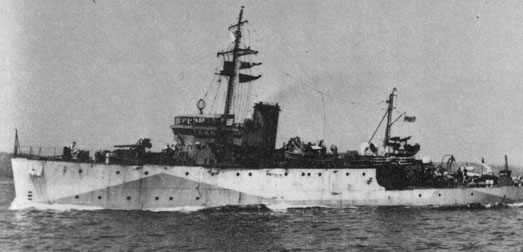
Picture compliments of book "Night of the Caribou."

Picture compliments of book "Night of the Caribou."
| The Minesweeper Grandmere was serving as the
escort ship for the Caribou on the night that it was sunk.
There has been some speculation that this vessel was not in sight of the Caribou during part of its voyage and Captain Taverner was quite concerned about not being able to see the vessel and in fact was against night crossings of the Strait. In a report after the incident Commodore H.E. Reid, Commander of the Canadian Naval Forces in Newfoundland, told the Government that the Grandmere was carrying out standard screening procedures and due to the secrecy of these matters he was unable to divulge the position of the vessel at the time of the sinking. He did however add that the vessels were only about 1,500 yards apart. Reid went on to say, “You will appreciate that the first duty of the escort vessel was to attack the submarine. If she had concentrated on picking up survivors, she would have subjected herself to the chances of a further attack in which she herself might have been sunk or the Caribou finished off.” In the end though this did not answer or clear up any speculation about the role of the Grandmere that night expect that it had been accompanying the Caribou and that it ended up picking up most of the 101 survivors. The ship
continued to do escorts and minesweeping until the end of the war and was
then turned over to the government’s War Assets Corporation for disposal. It
was sold to Saguenay Terminals Ltd., Montreal and was converted into a
yacht. By 1951 she was under British registry and was sailing out of Nassau,
Bahamas and in 1959 she was sailing between various ports in Florida and
Cuba under the name Jack’s Bay. Le dragueur de mines Grandmere était portion comme bateau d'escorte pour le Caribou la nuit qu'il a été descendu. Il y a eu de la spéculation que ce navire n'était pas en vue du Caribou pendant la partie de son voyage et capitaine Taverner était tout à fait intéressé au sujet de ne pas pouvoir voir que le navire et dans le fait était contre des croisements de nuit du détroit. Dans un rapport après le commodore H.E. Reid, commandant d'incident des forces navales canadiennes dans Terre-Neuve, a dit au gouvernement que le Grandmere suivait des procédures de criblage standard et en raison du secret de ces sujets qu'il ne pouvait pas divulguer la position du navire à l'heure de la descente. Il a cependant ajouté que les navires étaient de seulement environ 1.500 yards de distants. Reid a continué pour indiquer, "vous apprécierez que le premier devoir du navire d'escorte devait attaquer le sous-marin. Si elle s'était concentrée sur sélectionner vers le haut des survivants, elle se serait soumise aux chances une autre d'attaque dans laquelle elle elle-même pourrait avoir été descendue ou le Caribou a fini." À la fin bien que ceci n'ait répondu ou n'ait pas éclairci à aucune spéculation au sujet du rôle du Grandmere que la nuit comptent qu'elle avait accompagné le Caribou et qu'il a fini vers le haut de la sélection vers le haut de la plupart des 101 survivants. Le bateau a continué à faire des escortes et le dragage de mines jusqu'à la fin de la guerre et a été puis retourné à War du gouvernement Assets Corporation pour la disposition. Il a été vendu à bornes Ltd, Montréal de Saguenay et a été converti en yacht. D'ici 1951 elle était sous l'enregistrement britannique et naviguait hors de Nassau, les Bahamas et en 1959 où elle naviguait entre de divers ports en Floride et le Cuba sous le nom du compartiment de Jack. |